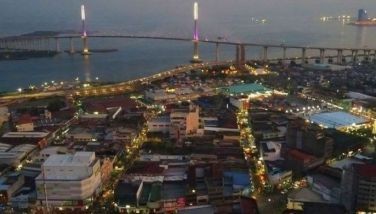Feature: When celosia farms go viral
CEBU, Philippines - With more netizens posting their photos with the red and yellow blooms of the Sinulog flowers or generally known as celosia, flower farms in Cebu City’s mountain barangay of Sirao are building hype over social media as a new tourist destination in the city.
Active social media user Raja Dan Jasmin, 22, said the Sirao Flower Farm had gone viral in social media since the tourist attraction cannot be found in the metropolis, and that with such scenery and vibrant hues of flowers, the place seems like a “little Baguio.”
Some netizens also branded the home to a number of celosia flower farms as the “#miniAmsterdam” in the country.
Jasmin was planning with his partner and friends to go to the flower farm last week after several photos taken by their friends flooded their feeds on social media. But they managed to visit the area only yesterday when most of them have found free time from their work.
Jasmin said the Sirao Flower Farm should be promoted and preserved as a tourist destination in Cebu.
Mia Abacahan, 23, call center employee, was surprised there were already many tourists when they visited the flower farm with her friends early yesterday morning.
She said they had planned the trip after seeing the Instagram post of a local blogger.
Abacahan wants to visit again next year, hoping to see more flowers growing in a larger area of the farm.
Both Jasmin and Abacahan posted their photos from the flower farm on their Facebook and Instagram accounts.
Celosia flowers, according to flower farmers, are being planted once a year in preparation for the observance of the All Saints’ Day and All Souls’ Day when the market demand is high.
They are members of the small genus of edible and ornamental plants belonging to the amaranth family of annual or short-lived perennial plants.
Celosia was formally declared as the Official Sinulog Flower by the Cebu City government in 2011 based on the colors of the cape of the Señor Sto Niño.
It is not a native of the country but was brought to Cebu by a delegation of Cebuanos who visited Haarlemmermeer, Netherlands in 1991.
The farmers would start planting celosia in July or August and the flowers would grow and bloom for three months. The flowers can then be harvested in the last week of October to be sold to vendors at Freedom Park in downtown Cebu City or to buyers from other areas such as Manila, Negros Oriental, and Iloilo.
Emerging tourist site in Cebu
Flower farmers, who have no social media accounts, did not expect their flowers to be that famous, saying they were overwhelmed by the recognition of their place as a new tourist site.
61-year-old Severino Ople Jr., a caretaker of one of the flower farms, said the owner of the farm instructed him not to harvest the flowers anymore and, instead, oversee the increasing number of tourists who come to take photos of the scenery.
Ople admitted they earn more from the picture-taking sessions of tourists than from selling the flowers in the market.
Tourists can take as many photos as they want in exchange of an entrance fee of P20.
Ople said the farm owner now plans to develop the area, which measures less than a hectare, and plant more celosias for next year.
He said the owner also even took a photo of her with the blooms in her farm as well. Ople, on the other hand, shared he did not even know the online jargons “selfie” and “groufie” that most tourists do upon their visit.
Ople said he did not foresee celosia flowers to become a favorite among tourists. He said the flowers are even sold cheap from P15 to P20 per bundle. Once being sold in the market, he said the prices may vary from P35 to P40.
He said that the craze started when a group of girls visited their flower farm last Saturday and take photos. From that day, they began seeing more tourists coming in.
Ople said since they began to entertain tourists last Saturday, they also started to collect P3,000 to P4,000 proceeds every day.
Ople said they used to earn P20,000 from selling the flowers. But now, he shared, they have already collected P40,000 in six days, just from collecting the entrance fees.
He said they start to entertain tourists at 6 a.m. as the earliest time of the day. Lesser people come at 9 a.m. onwards when the sun is at its peak. Visitors would come back at 3 p.m. until 6 p.m.
Ople said most of the tourists are students.
Beside Ople’s celosia farm is another hotspot for tourists. But unlike Ople, Felipe Borres,73, said they have stopped collecting entrance fees from the visitors and started harvesting the celosia flowers yesterday.
“Maluoy pud bitaw ko kay molabang man diretso ang mga turista diri gikan sa pikas. Unya usahay di na lang mi maningil balik. Maikog pud mi maningil ron kay nag-harvest na man mi,” he said.
Borres said they also started collecting entrance fees since Saturday. In the lot being manned by Borres, tourists can opt to take their photos from the 50-meter flower farm on a flat terrain or take a few more steps going to the 20-meter celosia farm on a highland, overlooking the scenic view of Metro Cebu.
Borres recalled that they used to earn P10,000 from selling the flowers but this year, they have already gained P5,000 from the entrance fees five days before their harvest yesterday.
Borres even wondered why the flower farms have become viral only now when they have long been growing the flowers for years and that they were even featured in the media.
He encouraged tourists taking photos of their farm to even buy flowers at P35 per bundle.
“Kining kadaghanon sa mga tawo, kabubut-on man ni nila. Ang amo pagtanom ra man. Kay nalingaw man ang mga tawo, mag-agad ra mi nila. Puede ra sila moari diri sa amo,” he said.
More income opportunities
Ramonito Comaling, 25, a motorcycle-for-hire driver for over seven years, said they were happy with the growing popularity of the Sirao Flower Farm since it means additional income for them.
He said their earnings grew from P400 in a normal day to more than double when they started serving more tourists going to the mountain barangay since Monday.
Comaling said a tourist can ride the habal-habal going to the flower farm for a fare of P100 to P150.
Edith de Alagdon, 25, and a resident of Sirao, said they started selling sweet corn yesterday along the road near the flower farm to take advantage of the influx of tourists.
Alagdon said they have been in the business long before but it was their first time to sell near the flower farm.
She said they earned P2,000 from selling the sweet corn on their first day. Each corn is priced at P20.
Alagdon added they will continue selling their products as long as there are visitors coming to the flower farms.
Reminder to tourists
Ople, however, asked visitors not to touch or step on the flowers to preserve their bloom until November 5 and just follow the trail where they can walk through the farm. He also asked the tourists not to throw garbage anywhere in the farm.
“Unta kon magpa-picture, di lang hilabtan ang mga buwak,” he said.
Ople said they are hesitant to reprimand the visitors and would end up picking the damaged flowers and the trash themselves.
He expressed concern about the lack of water supply, which makes it difficult for them to continue growing more plants in time for the Sinulog Festival.
“Patamnan unta para Sinulog pero di magsilbi ang init. Tubig ang kinahanglan ani. Kung mouwan mas maayo,” he said. — /LPM (FREEMAN)
- Latest























